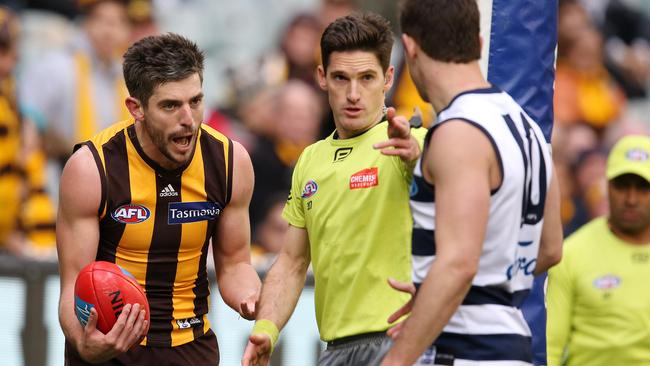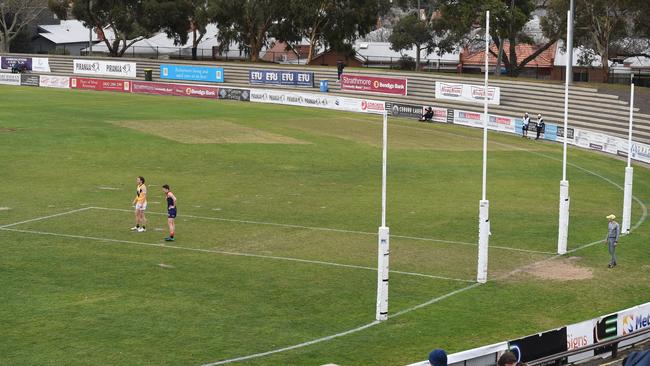AFL’s nine new rules should help stop defensive strangulation, but the proof is still to come
AFTER 10 months of data collection, trials and input from the game’s greats, the AFL has revealed nine new rules changes. They look good if you want more open football, writes Mark Robinson.

Mark Robinson
Don't miss out on the headlines from Mark Robinson. Followed categories will be added to My News.
THEY are the nine commandments of evolution, according to the AFL.
They will correct the imbalance, the league says, of defence overwhelming the offence and it’s difficult to argue that premise when you consider scoring is at the lowest average since 1968.
They will create more run and creativity and coaching strategies, they say.
REVEALED: THE NINE RULE CHANGED REVIEWED
VOTE: WHO WAS THE NO.1 PLAYER IN 2018?
The game will be more bombastic from the kick-ins, they say, and they have re-armed the key forwards by scrapping the hands-in-the-back rule.
It all sounds cosy and cute and adventurous, but, of course, the proof will be in the pudding.
The new rules, which will be used in the pre-season competition and be adopted for the season proper, have been fully endorsed by the Competition Committee and supported by the AFL Commission.

The principle of a) opening up the game and b) restricting the ability of the defending team to set up quickly looks to have been addressed - in principle.
The AFL is pleased with the outcome and now will start the arduous task of convincing and educating the fans that all this is right.
My gut feel says the rules won’t harm the fabric of the game.
Four of the rules are hardly radical.
Hands in the back, which was introduced 12 years ago, has been scrapped which will allow key forwards and defenders to use their strength to defend the drop of the ball, which is partly a good outcome and partly a terrible outcome.
Flopping and diving will return, and players will be penalised for it, and of course each contest will need to be interpreted by an individual umpire.
What Razor Ray sees as a push, Matt Stevic sees as fair.
Crowd participation will be at maximum.

Cracking down on umpire contact is a given, ruckmen taking the ball out of the ruck will not be regarded as prior opportunity and is a return to the original ruling anyway and 6-6-6 starting positions is the norm rather than the radical.
The good news is the ruck rule should mean the game no longer has a single ruckman contesting a stoppage or throw-in, which was a stain.
Fewer runners and water boys is ho-hum unless you are the coach of an inexperienced team, or a player who gets real thirsty.
AFL great Paul Roos says young teams need three runners, not less time for runners.
But the AFL argues that high interchange rotations gives an opportunity to pass on messages.
They also believe there is potential for senior coaches to coach from the bench and greater education and teaching during the week.
The challenging change to traditional thinking is the kick-in, but the AFL has worked this one beautifully.
The much-vaunted 18m goalsquare was scrapped and you have to think the Commission jumped all over it at their September meeting.

It was trialled and received push back from fans. The AFL had to listen.
Instead, they have a instituted a kick-in mechanism that has all the benefit of more room for the full-back, without the ugliness of the white line.
Same outcome, different lever.
The ever-expanding strategies of coaches will be most curious. It raises a host of questions.
Who do they use to kick in? A long-ball specialist such as Zach Tuohy or the run-and-gun playmakers such as Lachie Whitfield?
How do they set-up in the centre square if their team is getting smashed? Do they position wings to the defensive point of the square as well as push a midfielder to the defensive line of the centre square to help as the spare defender?
Which of the coaches will be innovators and which ones will be sheep?
Nine changes - after 10 months of data gathering, game watching (historic and modern) and trials and testing - are fewer than what was expected and certainly not the panacea for widespread fear of change.
There could easily have been more.
There was no address of incorrect disposal and prior opportunity, although it is expected the AFL will instruct umpires to adjudicate to the letter of the law.
Make no mistakes, this will be central to the AFL’s desire to open up the game.


